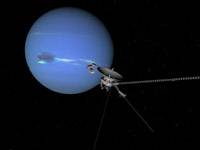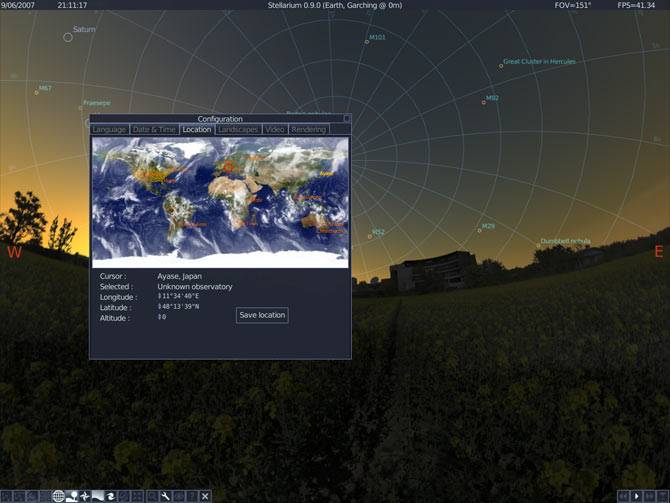|
|
|
|
|
|
|
||
|
Новости: подробнее 526229 января 2008 г. 10:40 Новинки ПО: Celestia 1.5.0 и Stellarium 0.9.1Спустя год после предыдущей версии, вышла новая версия кросс-платформенного бесплатного астрономического планетария Celestia 1.5.0. Эта программа используется NASA и ESA. Пока доступны версии для Windows и Mac OS X. Для Linux новая версия выйдет чуть позже. Используется API OpenGL. Список изменений, по сравнению с предыдущей версией 1.4.1 просто огромен:Improved rendering: Список изменений, по сравнению с предыдущей версией 1.4.1 просто огромен:Improved rendering: - Support for specular textures an normal maps for meshes - Display of eclipse shadows cast onto meshes - Per-pixel specular lighting for higher-quality specular highlights, i.e. fewer tessellation artifacts. This is especially noticeable with low polygon models with specular materials. - Normal maps and specular materials can now be applied at the same time, for 'bumpy-shiny' effects - Simulated scattering, for much more realistic rendering of planetary atmospheres. - Lunar-Lambert photometric model for more realistic rendering of dust covered bodies such as the moon. - Support for compressed normal maps; eliminates the need to use huge amounts of texture memory for high quality normal maps.* Flexible reference frames - Celestia now supports flexible reference frames for specifying object trajectories and orientations. This makes it easier to import new objects into Celestia that have orbits defined in some reference frame other than the default ones enforced in 1.4.1. - New reference frames: - J2000Ecliptic: defined by the ecliptic and equinox of J2000.0. This is the default for objects orbiting stars. It may now be specified for other objects as well. - J2000Equator: defined by the Earth equator and ecliptic of J2000.0. - MeanEquator: reference frame defined by the equator of some arbitrary object. This was previously the default and only reference frame available for solar system bodies that didn't directly orbit stars. - BodyFixed: a reference frame that rotates with smoe specified object - TwoVector: a flexible system for defining reference frames based on two vectors, either a constant vector, object-to-object direction, or velocity vector. Useful for local attitude frames (among other things.) - Separate reference frames may be defined for the position and orientation of an object. As an example, it may be useful to specify the trajectory of an Earth-orbiting satellite in an Earth equatorial frame while its attitude is specified in an LVLH frame. - A new solar system object called a ReferencePoint is available. This is useful for defining the origin of a reference frame that doesn't happen to lie at the center of a planet, moon, or spacecraft.* New trajectory types: - FixedPosition: For placing an object at a fixed point within its reference frame. - ScriptedOrbit: Allows the position of an object to be controlled by a Lua script. - SampledTrajectory: A more flexible version of SampledOrbit, with the option to specify single or double precision and cubic or linear interpolation.* New rotation models: - In previous versions of Celestia, all objects rotated uniformly about a single axis (with optional precession about the z-axis.) Celestia 1.5.0 introduces the concept of a generic rotation model, which is some function that specifies the orientation of an object over time. - Rotation models available in Celestia 1.5.0: - FixedRotation: For an object with an orientation that remains fixed within its reference frame. This was a notable omission in older version of Celestia. - UniformRotation: Describes a rotation of a constant rate about a fixed axis. - PrecessingRotation: UniformRotation plus a precession rate. - SampledOrientation: Analagous to SampledOrbit for position. SampledOrientation specifies a file of time tagged quaternions which are interpolated to give the orientation of an object. - ScriptedRotation: Allows the orientation of an object to be controlled by a Lua script.* Galaxies: - Catalog improvements: - Included the complete local group of galaxies. - Updated catalog so that nearly 100% of galaxies now have distances. - Added support for custom galaxy templates; created a custom Milky Way template with all known galactic arms. - Improved appearance of Milky Way as seen from Earth. - Accelerated loading of large catalog files by using an improve name index (measured over 100x performance increase for 100k+ object catalogs) - Implemented distance-based fading of labels.* Data file updates: - Extrasolar planets: added about 50 recently discovered extrasolar planets, and revised orbits of known ones based on new data. data. - Solar System: Added newly discovered outer planet satellites and names - Locations: Added new IAU names for features on planets, moons, and asteroids. - Near stars: Updated near star catalog with latest data from RECONS - Binary stars: Updated the binary orbit data in visual and spectroscopic binary catalogs, and included scripts that document the extraction of information in scientific data sets for use in Celestia star catalogs. - A new set of higher resolution textures was added for the Moon and several satellites of Saturn.* CELX Scripting improvements: - OpenGL drawing commands allow scripts to display custom graphics on screen. - ScriptedOrbits and ScriptedRotations provide hooks for objects to be positioned and oriented with scripts. - The Lua hook mechanism gives CELX scripts the ability to handle mouse, keyboard, and tick events. - Many other CELX functions to enable scripts to accomplish much of what used to be possible only by modifying the Celestia source code. - Scripts may now be loaded quickly from the new Scripts menu. - Updated CELX interpreter from Lua 5.0 to Lua 5.1* Accuracy - Established Barycentric Dynamical Time (TDB) as the time scale used internally by Celestia. - Established the origin of Celestia's coordinate system as the Solar System Barycenter and the reference frame as J2000 ecliptical. - Fixed support for JPL ephemerides. It is now posible to use the JPL DE405 and DE406 ephemerides whenever extremely accurate positions for the Moon and planets are required. - Added an orbit for the Sun around the solar system barycenter* SPICE support: Celestia can now use extremely accurate planet orbits and spacecraft trajectories available in SPICE SPK files from JPL.* Orbit rendering - Orbits are now properly depth sorted with respect to other solar system objects. They are no longer improperly drawn in front of objects that they are behind, and vice versa. - The jittering of orbit paths viewed at close distances has been reduced - Cubic splines are used to reduce the appearance of sharp angles in between orbit segments. This also has the effect of placing the rendered orbit path much closer to the the actual orbit path. - Star orbit paths are now shown, and may be toggled on and off indepently of the orbits for other objects.* Translation: - Windows version finally supports multiple languages - New translations: Ukrainian, Russian, Arabic, Dutch, Chinese, Korean, Bulgarian. - All other languages updated - Added translations for constellations names.* Miscellaneous - Added dynamic star labeling - Added support for labeled markers and new marker symbols - Enhanced InfoURLs so that they can refer to local files. - Added the capability to show reference vectors for objects, including frame axes, body axes, velocity vector, and sun direction. - Made label and line colors customizable via script. - Bound Shift+K and Shift+L to reduce or increase the time rate by a factor of 2.* Annoying bugs fixed: - Fixed the video recording rate on Windows - Bad calculation of specular exponent when loading 3DS models. This caused models with specular materials to look very different in Celestia than they did in 3D modeling software. - Fixed precision problems that caused location labels to disappear and jitter at close range. - Implemented more robust handling of script errors so that they don't cause Celestia to crash. - Allow scripts to run before the first frame is rendered so that they can set the starting observer position. - Switched to double precision for rotation and precession periods; among other things, this keeps synchronous rotators from drifting out of sync. - Implemented adaptive tesselation for comet tails based on their size on screen. This makes comet tails appear smooth when seen up close. - Clamped the simulation time to prevent going too far into the past or future. - Fixed the cmod loader to work properly on 64-bit systems. A nasty bug was preventing 64-bit Linux versions of Celestia from displaying spacecraft. - Fixed problems with the displayed time rate getting out of sync with the actual time rate.Скачать (Windows, Mac OS X, исходные коды программы).. Также, недавно появилась новая версия Stellarium 0.9.1 - бесплатного планетария с открытыми исходными кодами. Программа показывает положение неба, которое видно в вашей местности в реальном времени. Программа помогает определять точное местонахождение астрономических объектов для наблюдения невооруженным взглядом, биноклем или телескопом. Программа использует API OpenGL.  Список изменений по сравнению с версией 0.9.0 немал:sky Список изменений по сравнению с версией 0.9.0 немал:sky
extra catalogues with more than 210 million stars asterisms and illustrations of the constellations constellations for ten different cultures images of nebulae (full Messier catalogue) realistic Milky Way very realistic atmosphere, sunrise and sunset the planets and their satellites interface
time control multilingual interface scripting to record and play your own shows fisheye projection for planetarium domes spheric mirror projection for your own dome graphical interface and extensive keyboard control telescope control visualisation
star twinkling shooting stars eclipse simulation skinnable landscapes, now with spheric panorama projection customisability
< Предыдущая новость | Лента | Поиск | Архив | Месяц | День | Следующая новость > |
Логотипы, торговые марки и прочие зарегистрированные знаки принадлежат их правообладателям.
Copyright © 2001 - 2025, Radeon.ru Team.
Перепечатка материалов запрещена.